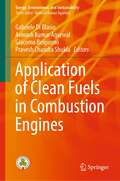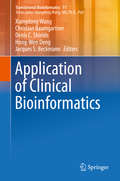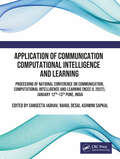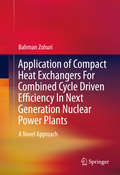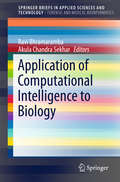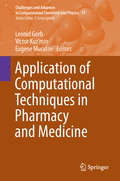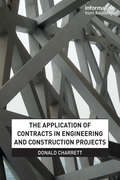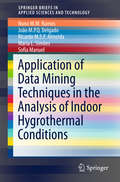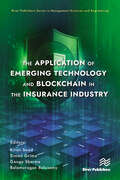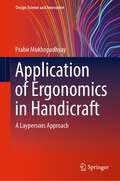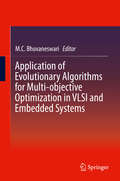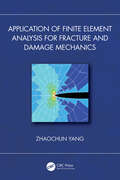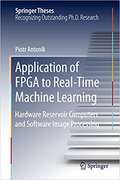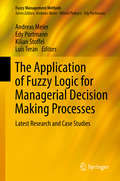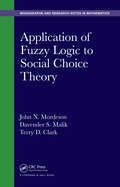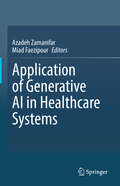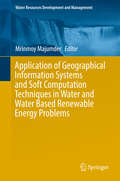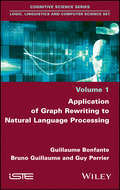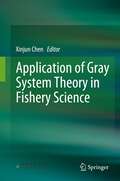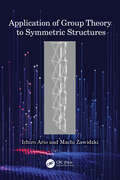- Table View
- List View
Application of Clean Fuels in Combustion Engines (Energy, Environment, and Sustainability)
by Avinash Kumar Agarwal Pravesh Chandra Shukla Giacomo Belgiorno Gabriele Di BlasioThis book discusses the impact of fuels characteristics and their effects on the combustion processes in internal combustion engines. It includes the analysis of a variety of biofuels (alcohol fuels and biodiesel) and biogases (natural gas, hydrogen, etc.), providing valuable information related to consequent effects on performance and emissions. The contents focus on recent results and current trends of fuel utilization in the transport sector. State-of-the-art of clean fuels application are also discussed. Thighs book will be of interest to those in academia and industry involved in fuels, IC engines, engine instrumentation, and environmental research.
Application of Clinical Bioinformatics (Translational Bioinformatics #11)
by Xiangdong Wang Christian Baumgartner Denis C. Shields Hong-Wen Deng Jacques S. BeckmannThis bookelucidates how genetic, biological and medical information can be applied tothe development of personalized healthcare, medication and therapies. Focusingon aspects of the development of evidence-based approaches in bioinformaticsand computational medicine, including data integration, methodologies, toolsand models for clinical and translational medicine, it offers an essentialintroduction to clinical bioinformatics for clinical researchers andphysicians, medical students and teachers, and scientists working with human disease-based omics and bioinformatics. Dr. XiangdongWang is a distinguished Professor of Medicine. He is Director of ShanghaiInstitute of Clinical Bioinformatics, Director of Fudan University Center forClinical Bioinformatics, Deputy Director of Shanghai Respiratory ResearchInstitute, Director of Biomedical Research Center, Fudan University ZhongshanHospital, Shanghai, China; Dr. Christian Baumgartner is a Professor of HealthCare and Biomedical Engineering at Institute of Health Care Engineering withEuropean Notified Body of Medical Devices, Graz University of Technology, Graz,Austria; Dr. Denis Shields is a Professor of ClinicalBioinformatics at Conway Institute, Belfield, Dublin, Ireland; Dr. Hong-Wen Dengis a Professor at Department of Biostatistics and Bioinformatics, Tulane UniversitySchool of Public Health and Tropical Medicine, USA; Dr. Jacques SBeckmann is a Professor and Director of Section of Clinical Bioinformatics,Swiss Institute of Bioinformatics, Switzerland.
Application of Communication Computational Intelligence and Learning: Proceeding of National Conference on Communication, Computational Intelligence and Learning (NCCC IL 2021), December 16th–17th Pune, India
by Sangeeta Jadhav; Rahul Desai; Ashwini SapkalThe special issue is dedicated to National conference on Communication, computational intelligence and learning-NCCCIL sponsored by AICTE and organized by Department of Information Technology at Army Institute of Technology from 12–13 January 2022. This conference gave the collaborative forum to academic experts, researchers and corporate professionals to enrich their knowledge in the automation and analysis of industry and business processes in a smart way. The two day conference included invited talks and paper presentations focusing on the applications of Computational intelligence, Communication, Machine Learning and Artificial Intelligence.
Application of Compact Heat Exchangers For Combined Cycle Driven Efficiency In Next Generation Nuclear Power Plants: A Novel Approach
by Bahman ZohuriCovers the fundamentals of combined-cycle plants to provide background for understanding the progressive design approaches at the heart of the text Discusses the types of compact heat exchanger surfaces, suggesting novel designs that can be considered for optimal cost effectiveness and maximum energy production Undertakes the thermal analysis of these compact heat exchangers throughout the life cycle, from the design perspective through operational and safety assurance stages This book describes the quest to create novel designs for compact heat exchangers in support of emergent combined cycle nuclear plants. The text opens with a concise explanation of the fundamentals of combined cycles, describing their efficiency impacts on electrical power generation systems. It then covers the implementation of these principles in nuclear reactor power systems, focusing on the role of compact heat exchangers in the combined cycle loop and applying them to the challenges facing actual nuclear power systems. The various types of compact heat exchanger surfaces and designs are given thorough consideration before the author turns his attention to discussing current and projected reactor systems, and how the novel design of these compact heat e xchangers can be applied to innovative designs, operation and safety analyses to optimize thermal efficiency. The book is written at an undergraduate level, but will be useful to practicing engineers and scientists as well.
Application of Computational Intelligence to Biology (SpringerBriefs in Applied Sciences and Technology)
by Ravi Bhramaramba Akula Chandra SekharThis book is a contribution of translational and allied research to the proceedings of the International Conference on Computational Intelligence and Soft Computing. It explains how various computational intelligence techniques can be applied to investigate various biological problems. It is a good read for Research Scholars, Engineers, Medical Doctors and Bioinformatics researchers.
Application of Computational Techniques in Pharmacy and Medicine (Challenges and Advances in Computational Chemistry and Physics #17)
by Leonid Gorb Victor Kuz'Min Eugene MuratovThe proposed volume provides both fundamental and detailed information about the computational and computational-experimental studies which improve our knowledge of how leaving matter functions, the different properties of drugs (including the calculation and the design of new ones), and the creation of completely new ways of treating numerical diseases. Whenever it is possible, the interplay between theory and experiment is provided. The book features computational techniques such as quantum-chemical and molecular dynamic approaches and quantitative structure-activity relationships. The initial chapters describe the state-of-the art research on the computational investigations in molecular biology, molecular pharmacy, and molecular medicine performed with the use of pure quantum-chemical techniques. The central part of the book illustrates the status of computational techniques that utilize hybrid, so called QM/MM approximations as well as the results of the QSAR studies which now are the most popular in predicting drugs' efficiency. The last chapters describe combined computational and experimental investigations.
The Application of Content Analysis in Nursing Science Research
by Helvi Kyngäs Kristina Mikkonen Maria KääriäinenThis book provides principles on content analysis and its application into development of nursing theory. It offers clear guidance to students, lecturers and researchers to gain a deeper understanding of the method of content analysis, its implementation into their own research and criteria of trustworthiness evaluation. The book is written in user-friendly language with provided research examples and cases, and the content is illustrated by figures and tables. The authors offer their expertise in providing a well thought through explanation of content analysis in didactical style, which will enhance university education. The book includes highly experienced researchers who have published articles on content analysis and the trustworthiness of the method with more than 10 000 citations. Divided into two parts, this book explores the application of content analysis into nursing science. The first part presents the philosophical position of content analysis, inductive and deductive methods of using content analysis, trustworthiness of the method, and ethical consideration of using content analysis. The second part informs on the theory development based on content analysis, conceptualization of the concepts of content analysis into generation of items and instrument development, and statistical testing of a hypothetical model. The last chapter shows a new approach to using content analysis in systematic reviews and quality evaluation of methodology within systematic review process. The book is an essential tool for nursing science, providing instruction on key methodological elements in order to provide rigorously conducted empirical research for clinical practice and nursing education.
The Application of Contracts in Developing Offshore Oil and Gas Projects
by Philip Loots Donald CharrettThis book provides a comprehensive overview of the key aspects and contracts involved in the process of developing oil and gas projects, with an emphasis on offshore developments. Project development in oil and gas carries with it numerous unique risks and challenges. By identifying and managing risk through the various contract stages, each stage of the project is seen in perspective and therefore gives readers a better understanding of how that stage was arrived at and what is expected to come later. To do this, the authors use illustrative international case studies from past and current projects, thereby deepening the reader’s understanding and awareness of risk from practical experience, as well as suggesting answers for those who are involved in developing oil and gas projects. The Application of Contracts in Developing Offshore Oil and Gas Projects is intended for project owners, project managers, contractors, finance managers, commercial managers and lawyers who seek to understand the subject from a practical point of view.
The Application of Contracts in Engineering and Construction Projects
by Donald CharrettWritten by an engineer and construction lawyer with many years of experience, The Application of Contracts in Engineering and Construction Projects provides unique and invaluable guidance on the role of contracts in construction and engineering projects. Compiling papers written and edited by the author, it draws together a lifetime of lessons learned in these fields and covers the topics a practicing professional might encounter in such a project, developed in bite-sized chunks. Key topics included are: the engineer and the contract; the project and the contract; avoidance and resolution of disputes; forensic engineers and expert witnesses; and international construction contracts. The inclusion of numerous case studies to illustrate the importance of getting the contract right before it is entered into, and the consequences that may ensue if this is not done, makes The Application of Contracts in Engineering and Construction Projects essential reading for construction professionals, lawyers and students of construction law.
Application of Data Mining Techniques in the Analysis of Indoor Hygrothermal Conditions (SpringerBriefs in Applied Sciences and Technology)
by Nuno M. M. Ramos João M. P. Q. Delgado Ricardo M. S. F. Almeida Maria L. Simões Sofia ManuelThe main benefit of the book is that it explores available methodologies for both conducting in-situ measurements and adequately exploring the results, based on a case study that illustrates the benefits and difficulties of concurrent methodologies. The case study corresponds to a set of 25 social housing dwellings where an extensive in situ measurement campaign was conducted. The dwellings are located in the same quarter of a city. Measurements included indoor temperature and relative humidity, with continuous log in different rooms of each dwelling, blower-door tests and complete outdoor conditions provided by a nearby weather station. The book includes a variety of scientific and engineering disciplines, such as building physics, probability and statistics and civil engineering. It presents a synthesis of the current state of knowledge for benefit of professional engineers and scientists.
The Application of Emerging Technology and Blockchain in the Insurance Industry (River Publishers Series in Management Sciences and Engineering)
by Kiran Sood Simon Grima Ganga Sharma Balamurugan BalusamyThis book is a unique guide to the disruptions, innovations, and opportunities that technology provides the insurance sector and acts as an academic/industry-specific guide for creating operational effectiveness, managing risk, improving financials, and retaining customers. It also contains the current philosophy and actionable strategies from a wide range of contributors who are experts on the topic. It logically explains why traditional ways of doing business will soon become irrelevant and therefore provides an alternative choice by embracing technology. Practitioners and students alike will find value in the support for understanding practical implications of how technology has brought innovation and modern methods to measure, control, and evaluation price risk in the insurance business. It will help insurers reduce operational costs, strengthen customer interactions, target potential customers to provide usage-based insurance, and optimize the overall business. Retailers and industry giants have made significant strides in adopting digital platforms to deliver a satisfying customer experience. Insurance companies must adjust their business models and strategies to remain competitive and take advantage of technology. Insurance companies are increasingly investing in IT and related technologies to improve customer experience and reduce operational costs. Innovation through new technologies is a key driver of change in the financial sector which is often accompanied by uncertainty and doubt. This book will play a pivotal role in risk management through fraud detection, regulatory compliances, and claim settlement leading to overall satisfaction of customers.
Application of Ergonomics in Handicraft: A Laypersons Approach (Design Science and Innovation)
by Prabir MukhopadhyayThis book is about the application of ergonomics in handicraft manufacturing and design keeping in mind the two sets of users, craftsmen and customers buying handicraft items. Written in an easy to understand language and in a story telling format. It requires no prior knowledge of the subject nor any knowledge of science or technology for using this book and applying it in handicraft manufacturing and design. The book starts with an overview of the application of ergonomics in different aspects of craft manufacturing, touching upon tools, space, process and then moves into the aspects of ergonomics of craft packaging and displaying. Alongside the book also explains the ergonomic aspects of designing of handicraft products keeping the users of the products in mind, their dimensions, capacity, limitations etc. Each chapter starts with an "overview" and ends with "key points" and exercises to help the readers in applying the principles of ergonomics in handicraft. The last chapter is dedicated to exercises in different areas of handicraft and the ergonomic applications for them, followed by ergonomic design directions to solve them.
Application of Evolutionary Algorithms for Multi-objective Optimization in VLSI and Embedded Systems
by M. C. BhuvaneswariThis book describes how evolutionary algorithms (EA), including genetic algorithms (GA) and particle swarm optimization (PSO) can be utilized for solving multi-objective optimization problems in the area of embedded and VLSI system design. Many complex engineering optimization problems can be modelled as multi-objective formulations. This book provides an introduction to multi-objective optimization using meta-heuristic algorithms, GA and PSO and how they can be applied to problems like hardware/software partitioning in embedded systems, circuit partitioning in VLSI, design of operational amplifiers in analog VLSI, design space exploration in high-level synthesis, delay fault testing in VLSI testing and scheduling in heterogeneous distributed systems. It is shown how, in each case, the various aspects of the EA, namely its representation and operators like crossover, mutation, etc, can be separately formulated to solve these problems. This book is intended for design engineers and researchers in the field of VLSI and embedded system design. The book introduces the multi-objective GA and PSO in a simple and easily understandable way that will appeal to introductory readers.
Application of Finite Element Analysis for Fracture and Damage Mechanics
by Zhaochun YangApplication of Finite Element Analysis for Fracture and Damage Mechanics focuses on the finite element analysis of various material models and their relevant fracture and damage models using this advanced software. The book consists of three parts: Part I introduces the various material models, Part II highlights the finite element modeling of their relevant fracture parameters, and Part III deals with various material damage models. Each part begins with a simple problem with theoretical results compared with finite element results to help readers understand the numerical simulation results. Discusses material models such as composite, elastic, elastoplastic, and creep models Covers fracture parameters like K, J, C*, and VCCT Presents relevant material damage models (ductile, creep, and composite) Explores typical and complex problems, including the inclined crack model, penny shaped crack model, compact tension specimen, end-loaded split (ELS) model, double cantilever beam (DCB) model, and notched model Includes all modeling files, such as APDL input files, Python code and creep damage subroutine, in the appendixes Written for materials and mechanical engineers, this text addresses and provides solutions to the real-life engineering challenge of damage and fracture in materials and structures.
The Application of Formal Methods: Essays Dedicated to Jim Woodcock on the Occasion of His Retirement (Lecture Notes in Computer Science #14900)
by Augusto Sampaio Simon FosterThis Festschrift, dedicated to Jim Woodcock, contains papers written by many of his closest collaborators. After a PhD on software verification at the University of Liverpool, Jim has combined a successful career in academia with outstanding industry research, in particular he has been a pioneer in applying mathematical modelling approaches in critical industries. At GEC's Hirst Research Centre he worked on a novel distributed telephone exchange and a service specification of a PABX exchange. In Oxford he collaborated with IBM Hursley Laboratories on modelling of the CICS transaction processing system, one of the most significant software systems ever. As part of the UK government's cybersecurity strategy, he used Z techniques to develop secure office automation systems and a secure version of UNIX. He worked with the Smith Institute and BR Research to verify the safety of railway signalling systems, approaches developed further in safety-critical control systems for the UK Nuclear Installation Inspectorate and British Energy. He provided a technically complete theory of correctness for Z, verifying its soundness from first principles, and completed the verification of Mondex, a smartcard-based electronic cash system, the first application of a general theory of program correctness to an industrial product. He coordinated the experimental work of the Verified Software Initiative, an international grand challenge. More recently he extended the collection of standard Unifying Theories of Programming (UTP) with work on object orientation and hybrid systems. Currently he is working on a UTP theory of probabilistic programs with application to robotics. Jim has been a lecturer, research fellow, reader and professor at the University of Surrey, the University of Oxford, the University of Kent, and since 2004 the University of York, and he is a visiting professor at the Federal University of Pernambuco and Trinity College Dublin. He is a Fellow of the Royal Academy of Engineering, the British Computer Society, and the Formal Methods Europe association, and he was part of the team that won the Queen’s Award for Technological Achievement in 1992. He is the Editor-in-Chief of the ACM journal Formal Aspects of Computing, he has chaired major related academic conferences, and he has contributed to CCITT and Z ISO international standards. Throughout all these activities, Jim has been a guide and inspiration to colleagues and students, and collaborated successfully with researchers in the UK, Brazil, China, France, USA, Ireland, and Singapore. Many of these researchers show in their contributions to this volume the ongoing impact of his work.
Application of FPGA to Real‐Time Machine Learning: Hardware Reservoir Computers And Software Image Processing (Springer Theses)
by Piotr AntonikNominated as an outstanding Ph.D. thesis by the Université libre de Bruxelles, Belgium.<p><p> Provides a thorough introduction to reservoir computing and field-programmable gate arrays Discusses the problems encountered on the path to the results discussed Uses an engaging and lively writing style.<p> This book lies at the interface of machine learning – a subfield of computer science that develops algorithms for challenging tasks such as shape or image recognition, where traditional algorithms fail – and photonics – the physical science of light, which underlies many of the optical communications technologies used in our information society. It provides a thorough introduction to reservoir computing and field-programmable gate arrays (FPGAs).<p> Recently, photonic implementations of reservoir computing (a machine learning algorithm based on artificial neural networks) have made a breakthrough in optical computing possible. In this book, the author pushes the performance of these systems significantly beyond what was achieved before. By interfacing a photonic reservoir computer with a high-speed electronic device (an FPGA), the author successfully interacts with the reservoir computer in real time, allowing him to considerably expand its capabilities and range of possible applications. Furthermore, the author draws on his expertise in machine learning and FPGA programming to make progress on a very different problem, namely the real-time image analysis of optical coherence tomography for atherosclerotic arteries.
The Application of Fuzzy Logic for Managerial Decision Making Processes
by Andreas Meier Edy Portmann Kilian Stoffel Luis TeránThis book addresses the latest research and applications of fuzzy management methods for business decisions. It showcases a broad set of applications and discusses topics such as measures for the quality of analytics outcomes in big data environments; how fuzzy management methods support the inclusion of human thinking and human behavior in decision making processes; how to generate better results with fuzzy management methods in cases of imprecise information; new personalization concepts enabled by fuzzy logic for the offering of customized products and services especially in the electronic market; and lastly the application of fuzzy analysis for executives using natural rather than computer language. The combination of research papers and case studies makes it a valuable resource both for researchers and practitioners in the digital economy.
Application of Fuzzy Logic to Social Choice Theory
by John N. Mordeson Davender S. Malik Terry D. ClarkFuzzy social choice theory is useful for modeling the uncertainty and imprecision prevalent in social life yet it has been scarcely applied and studied in the social sciences. Filling this gap, Application of Fuzzy Logic to Social Choice Theory provides a comprehensive study of fuzzy social choice theory.The book explains the concept of a fuzzy max
Application of Generative AI in Healthcare Systems
by Azadeh Zamanifar Miad FaezipourGenerative AI has immensely influenced various fields, such as education, marketing, art and music, and especially healthcare. Generative AI can benefit the patient through various approaches. For instance, it can enhance the image qualities negatively affected by radiation reduction, preventing patients from needing to repeat the image-taking process. Also, the generation of one type of image from another more expensive one can help patients save funds. Generative AI facilitates the administrative process, letting the doctor focus more on the treatment process. It even goes further by helping medical professionals with diagnosis and decision- making, suggesting possible treatment plans according to the patient symptoms. This book introduces several practical GenAI healthcare applications, especially in medical imaging, pandemic prediction, synthetic data generation, clinical administration support, professional education, patient engagement, and clinical decision support, providing a review of efficient GenAI tools and frameworks in this area. GenAI empowers the treatment process through several methods; however, some ethical, privacy, and security challenges require attention. Despite the challenges presented, GenAI technological and inherited characteristics smooth the path of improvement for it in the future.
Application of Geochemical Tracers to Fluvial Sediment (SpringerBriefs in Earth Sciences)
by Jerry R. Miller Gail Mackin Suzanne M. Orbock MillerThis book takes an in-depth look at the theory and methods inherent in the tracing of riverine sediments. Examined tracers include multi-elemental concentration data, fallout radionuclides (e. g. , 210Pb, 137Cs, 7Be), radiogenic isotopes (particularly those of Pb, Sr, and Nd), and novel ("non-traditional") stable isotopes (e. g. , Cd, Cu, Hg, and Zn), the latter of which owe their application to recent advances in analytical chemistry. The intended goal is not to replace more 'traditional' analyses of the riverine sediment system, but to show how tracer/fingerprinting studies can be used to gain insights into system functions that would not otherwise be possible. The text, then, provides researchers and catchment managers with a summary of the strengths and limitations of the examined techniques in terms of their temporal and spatial resolution, data requirements, and the uncertainties in the generated results. The use of environmental tracers has increased significantly during the past decade because it has become clear that documentation of sediment and sediment-associated contaminant provenance and dispersal is essential to mitigate their potentially harmful effects on aquatic ecosystems. Moreover, the use of monitoring programs to determine the source of sediments to a water body has proven to be a costly, labor intensive, long-term process with a spatial resolution that is limited by the number of monitoring sites that can be effectively maintained. Alternative approaches, including the identification and analysis of eroded upland areas and the use of distributed modeling routines also have proven problematic. The application of tracers within riverine environments has evolved such that they focus on sediments from two general sources: upland areas and specific, localized, anthropogenic point sources. Of particular importance to the former is the development of geochemical fingerprinting methods that quantify sediment provenance (and to a much lesser degree, sediment-associated contaminants) at the catchment scale. These methods have largely developed independently of the use of tracers to document the source and dispersal pathways of contaminated particles from point-sources of anthropogenic pollution at the reach- to river corridor-scale. Future studies are likely to begin merging the strengths of both approaches while relying on multiple tracer types to address management and regulatory issues, particularly within the context of the rapidly developing field of environmental forensics.
Application of Geographical Information Systems and Soft Computation Techniques in Water and Water Based Renewable Energy Problems (Water Resources Development and Management)
by Mrinmoy MajumderThis book highlights the application of Geographical Information System (GIS) and nature based algorithms to solve the problems of water and water based renewable energy resources. The irregularity in availability of resources and inefficiency in utilization of the available resources has reduced the potentiality of water and water based renewable energy resources. In recent years various soft computation methods (SCM) along with GIS were adopted to solve critical problems. The book collects various studies where many SCMs were used along with GIS to provide a solution for optimal utilization of natural resources for satisfying the basic needs of the population as well as fulfilling their burgeoning energy demands. The articles depict innovative application of soft computation techniques to identify the root cause and to mitigate the uncertainty for optimal utilization of the available water resources. The advantage of SCM and GIS were used to maximize the utilization of water resources under cost and time constraints in face of climatic abnormalities and effect of rapid urbanization.
Application of Geometric Algebra to Electromagnetic Scattering: The Clifford-Cauchy-Dirac Technique
by Andrew SeagarThis work presents the Clifford-Cauchy-Dirac (CCD) technique for solving problems involving the scattering of electromagnetic radiation from materials of all kinds. It allows anyone who is interested to master techniques that lead to simpler and more efficient solutions to problems of electromagnetic scattering than are currently in use. The technique is formulated in terms of the Cauchy kernel, single integrals, Clifford algebra and a whole-field approach. This is in contrast to many conventional techniques that are formulated in terms of Green's functions, double integrals, vector calculus and the combined field integral equation (CFIE). Whereas these conventional techniques lead to an implementation using the method of moments (MoM), the CCD technique is implemented as alternating projections onto convex sets in a Banach space. The ultimate outcome is an integral formulation that lends itself to a more direct and efficient solution than conventionally is the case, and applies without exception to all types of materials. On any particular machine, it results in either a faster solution for a given problem or the ability to solve problems of greater complexity. The Clifford-Cauchy-Dirac technique offers very real and significant advantages in uniformity, complexity, speed, storage, stability, consistency and accuracy.
Application of Graph Rewriting to Natural Language Processing
by Guillaume Bonfante Bruno Guillaume Guy PerrierThe paradigm of Graph Rewriting is used very little in the field of Natural Language Processing. But graphs are a natural way of representing the deep syntax and the semantics of natural languages. Deep syntax is an abstraction of syntactic dependencies towards semantics in the form of graphs and there is a compact way of representing the semantics in an underspecified logical framework also with graphs. Then, Graph Rewriting reconciles efficiency with linguistic readability for producing representations at some linguistic level by transformation of a neighbor level: from raw text to surface syntax, from surface syntax to deep syntax, from deep syntax to underspecified logical semantics and conversely.
Application of Gray System Theory in Fishery Science
by Xinjun ChenThis book reviews the gray system and combines its latest research results in fishery science. The chapters cover the basic concept and theory of gray system, original data processing and gray sequence generation, gray correlation analysis, gray cluster analysis, gray system modeling, gray prediction, gray decision-making, and gray linear programming. The theory of gray system is a new cross-sectional discipline founded in 1982 by Professor Deng Julong, a well-known scholar in China. In recent decades, it has not only been deepened and expanded in theory but also widely used in the fields of society, economy, ocean, agriculture, fishery, and other fields, and made a series of significant scientific achievements. These have laid the foundation for the important position of the gray system theory. Due to the great uncertainty of the fishery resources and the fishery environment involved in the fishery science system, which is completely different from the natural resources on the land, the data and information belong to the category of “poor information”, and the variability and uncertainty are greater than other natural resources. As an extremely effective analytical method and tool, gray system theory has been applied increasingly in fishery science. The book is developed based on well-read and practical literature and will help scientists and research units engaged in scientific research and teaching in fishery science and related fields to develop new research methods and tools.
Application of Group Theory to Symmetric Structures
by Ichiro Ario Machi ZawidzkiArio and Zawidzki show readers how to handle symmetric structures in engineering using group-theoretic bifurcation theory as a mathematical tool for the finite element analysis of symmetric structures.They guide the reader from the initial mathematical concepts through to application examples. Readers will gain a solid theoretical grounding in group theory and strong working knowledge of the use of computational frameworks for structural analysis using mathematical representations of symmetry and physical symmetry. First, the authors elaborate an outline of symmetric structures in engineering and then describe the representation of symmetry and group theory. They then discuss block diagonalization theory and finite element analysis models. This provides readers with the base knowledge needed for Chapter 6, which is based on numerical analysis examples of invariant, static FEM model systems and dynamic model systems of the dihedral group. This unique approach is a vital method that will enable readers to reduce the time and computation needed for accurate analysis so that they can better design such structures. The focus on finite element methods and practical examples and case studies throughout provides a strong practical foundation for anyone studying or working in this field.The book is a valuable resource for undergraduate and postgraduate students on various courses such as civil and mechanical engineering, architecture, structural engineering, applied mathematics, and physics. Additionally, it describes vital practical solutions for structural engineers, structural system manufacturers, fabricators of prefabricated elements, and developers of computational mechanics and so on.
